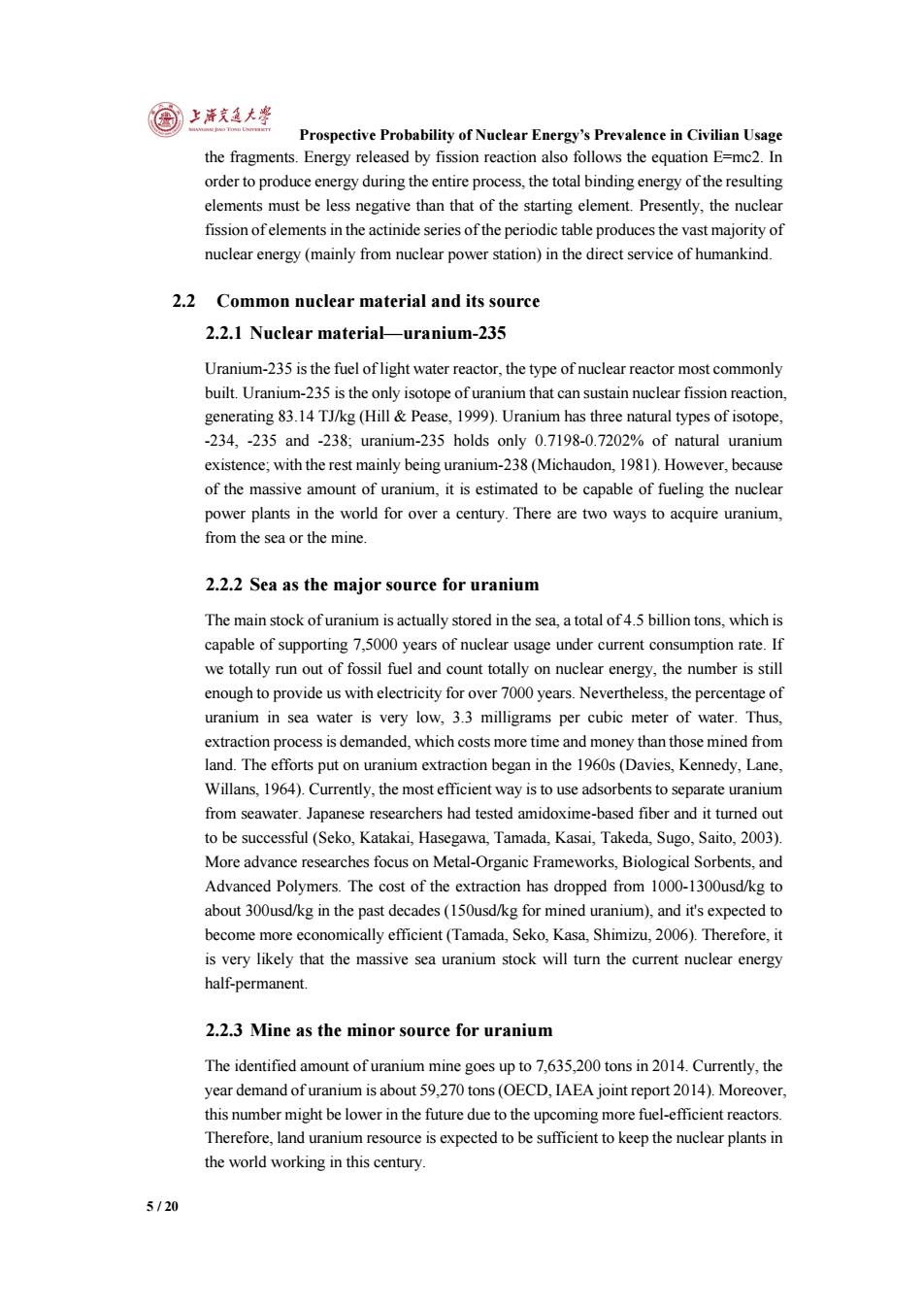正在加载图片...

上充益大粤 Prospective Probability of Nuclear Energy's Prevalence in Civilian Usage the fragments.Energy released by fission reaction also follows the equation E=mc2.In order to produce energy during the entire process,the total binding energy of the resulting elements must be less negative than that of the starting element.Presently,the nuclear fission ofelements in the actinide series of the periodic table produces the vast majority of nuclear energy(mainly from nuclear power station)in the direct service of humankind. 2.2 Common nuclear material and its source 2.2.1 Nuclear material-uranium-235 Uranium-235 is the fuel of light water reactor,the type of nuclear reactor most commonly built.Uranium-235 is the only isotope of uranium that can sustain nuclear fission reaction, generating 83.14 TJ/kg (Hill Pease,1999).Uranium has three natural types of isotope, -234,-235 and -238;uranium-235 holds only 0.7198-0.7202%of natural uranium existence;with the rest mainly being uranium-238(Michaudon,1981).However,because of the massive amount of uranium,it is estimated to be capable of fueling the nuclear power plants in the world for over a century.There are two ways to acquire uranium, from the sea or the mine. 2.2.2 Sea as the major source for uranium The main stock of uranium is actually stored in the sea,a total of 4.5 billion tons,which is capable of supporting 7,5000 years of nuclear usage under current consumption rate.If we totally run out of fossil fuel and count totally on nuclear energy,the number is still enough to provide us with electricity for over 7000 years.Nevertheless,the percentage of uranium in sea water is very low,3.3 milligrams per cubic meter of water.Thus, extraction process is demanded,which costs more time and money than those mined from land.The efforts put on uranium extraction began in the 1960s(Davies,Kennedy,Lane, Willans,1964).Currently,the most efficient way is to use adsorbents to separate uranium from seawater.Japanese researchers had tested amidoxime-based fiber and it turned out to be successful(Seko,Katakai,Hasegawa,Tamada,Kasai,Takeda,Sugo,Saito,2003). More advance researches focus on Metal-Organic Frameworks.Biological Sorbents.and Advanced Polymers.The cost of the extraction has dropped from 1000-1300usd/kg to about 300usd/kg in the past decades (150usd/kg for mined uranium).and it's expected to become more economically efficient(Tamada,Seko,Kasa,Shimizu,2006).Therefore,it is very likely that the massive sea uranium stock will turn the current nuclear energy half-permanent. 2.2.3 Mine as the minor source for uranium The identified amount of uranium mine goes up to 7,635,200 tons in 2014.Currently,the year demand of uranium is about 59,270 tons(OECD,IAEA joint report 2014).Moreover, this number might be lower in the future due to the upcoming more fuel-efficient reactors. Therefore,land uranium resource is expected to be sufficient to keep the nuclear plants in the world working in this century. 5/20Prospective Probability of Nuclear Energy’s Prevalence in Civilian Usage 5 / 20 the fragments. Energy released by fission reaction also follows the equation E=mc2. In order to produce energy during the entire process, the total binding energy of the resulting elements must be less negative than that of the starting element. Presently, the nuclear fission of elements in the actinide series of the periodic table produces the vast majority of nuclear energy (mainly from nuclear power station) in the direct service of humankind. 2.2 Common nuclear material and its source 2.2.1 Nuclear material—uranium-235 Uranium-235 is the fuel of light water reactor, the type of nuclear reactor most commonly built. Uranium-235 is the only isotope of uranium that can sustain nuclear fission reaction, generating 83.14 TJ/kg (Hill & Pease, 1999). Uranium has three natural types of isotope, -234, -235 and -238; uranium-235 holds only 0.7198-0.7202% of natural uranium existence; with the rest mainly being uranium-238 (Michaudon, 1981). However, because of the massive amount of uranium, it is estimated to be capable of fueling the nuclear power plants in the world for over a century. There are two ways to acquire uranium, from the sea or the mine. 2.2.2 Sea as the major source for uranium The main stock of uranium is actually stored in the sea, a total of 4.5 billion tons, which is capable of supporting 7,5000 years of nuclear usage under current consumption rate. If we totally run out of fossil fuel and count totally on nuclear energy, the number is still enough to provide us with electricity for over 7000 years. Nevertheless, the percentage of uranium in sea water is very low, 3.3 milligrams per cubic meter of water. Thus, extraction process is demanded, which costs more time and money than those mined from land. The efforts put on uranium extraction began in the 1960s (Davies, Kennedy, Lane, Willans, 1964). Currently, the most efficient way is to use adsorbents to separate uranium from seawater. Japanese researchers had tested amidoxime-based fiber and it turned out to be successful (Seko, Katakai, Hasegawa, Tamada, Kasai, Takeda, Sugo, Saito, 2003). More advance researches focus on Metal-Organic Frameworks, Biological Sorbents, and Advanced Polymers. The cost of the extraction has dropped from 1000-1300usd/kg to about 300usd/kg in the past decades (150usd/kg for mined uranium), and it's expected to become more economically efficient (Tamada, Seko, Kasa, Shimizu, 2006). Therefore, it is very likely that the massive sea uranium stock will turn the current nuclear energy half-permanent. 2.2.3 Mine as the minor source for uranium The identified amount of uranium mine goes up to 7,635,200 tons in 2014. Currently, the year demand of uranium is about 59,270 tons (OECD, IAEA joint report 2014). Moreover, this number might be lower in the future due to the upcoming more fuel-efficient reactors. Therefore, land uranium resource is expected to be sufficient to keep the nuclear plants in the world working in this century